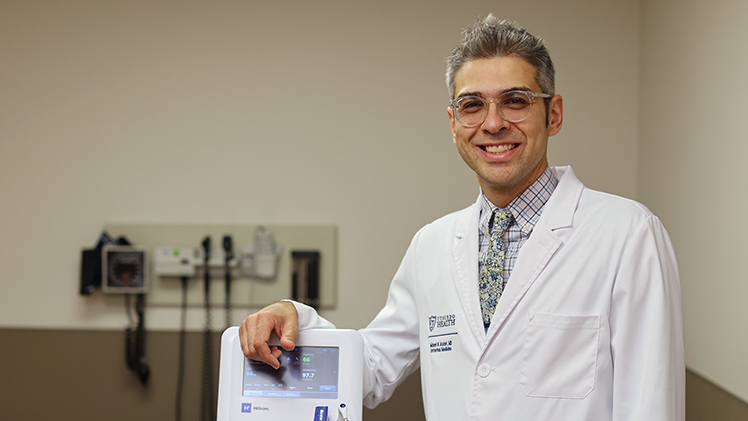Think back to the last time you had your blood pressure checked at your doctor’s office.
Were you quietly settled into a chair, calm and relaxed? Or had you just shuffled in from the waiting room to face rapid-fire questions about your medical history while you tried to remember if you take 10 milligrams or 20 milligrams of that prescription medicine you can’t really pronounce?

Dr. Mani Askari, a UToledo Health internal medicine specialist, poses with an automated machine that can take blood pressure measurements without a medical professional in the room, which helps reduce patient anxiety and gives doctors better data.
“We talk so much about the importance of knowing your blood pressure, but accuracy matters just as much as awareness,” said Dr. Mani Askari, a UToledo Health internal medicine specialist. “Too often, we’re not taking the time to measure it right.”
At the UToledo Health Comprehensive Care Center, primary care providers are pairing new technology with good-old-fashioned education to ensure their patients get an accurate readout and receive the best possible care based on their individual numbers.
High blood pressure, also known as hypertension, can significantly increase your risk factor of heart disease and stroke, two of the leading causes of death worldwide. It’s also extremely common. Nearly half of all U.S. adults have hypertension, which is currently defined by a blood pressure reading at or above 130/80.
To get a proper blood pressure reading, a patient should be relaxed for about five minutes before their blood pressure is taken. They should be seated, with their back supported and feet flat on the ground. They shouldn’t be talking, and their bladder should be empty.
Not following those guidelines can result in an artificially inflated number, potentially signaling hypertension when a patient’s true blood pressure is normal — yet Askari said the guidelines are not always followed. Many patients also experience what’s known as white coat hypertension, in which the anxiety of being in a doctor’s office can cause a temporary spike in blood pressure.
To combat that, the internal medicine clinic at the Comprehensive Care Center deployed new machines that allow for fully automated blood pressure readings. With the high-tech devices, which do not require a medical provider to be in the room while they operate, and ongoing staff training on proper patient preparation, UToledo Health is able to collect more exact readings.
“There may be some patients who the only reason their blood pressure is high is because of the stress,” said Askari, who also is a Certified Hypertension Specialist. “We want to avoid treating people who don’t need treatment, and for those who do need intervention, we want to know if it’s working or if we need to escalate our treatment.”
When a patient is taken to their exam room for a primary care visit at the Comprehensive Care Center, they’ll receive a familiar check-in. Medications. Medical history. Visit purpose. Other concerns they want to discuss.
Instead of having their blood pressure checked at the same time, however, the medical assistant straps a cuff on their arm and leaves the room.
Five minutes later, while the patient sits in the room by themselves, an automated office blood pressure monitor whirs into action, taking multiple blood pressure measurements at a set interval — usually about a minute apart.
The automation also ensures patients are checked at least twice at each visit, in line with current guidelines from the American Heart Association.
To see how effective the new protocols were, Askari led a study that looked at how well hypertensive patients had their blood pressure under control and how often internal medicine patients at the Comprehensive Care Center were having their blood pressure checked more than once at each appointment.
The project, which followed more than 2,800 hypertensive patients over the course of a year and included staff training conducted by Jennifer Gilmore, clinical research manager in the Department of Medicine, found recheck adherence rose from 59% before the addition of automated office blood pressure monitors to 96% after they were in use.
They also found that more than 79% of those hypertensive patients had their blood pressure under control based on readings from the unobserved monitors, versus 74% before they were put in use.
The improvement was even more substantial among patients 65 and younger, with 75% having their blood pressure under control after the changes, versus just 50% before the changes were put in place.
The results were published this spring in the peer-reviewed journal Discover Medicine.
“We need to make sure that we’re using the latest technology for the benefit of our patients,” Askari said. “These machines work, and the study shows the importance of getting accurate data. We didn’t change anything else. All we did is start doing a better job of getting an accurate reading. With better data comes more effective treatment and better overall wellness.”
Though the research looked only at internal medicine patients with diagnosed hypertension, unobserved blood pressure readings are now standard practice for all family medicine and internal medicine patients at the Compressive Care Center.
If you need a primary care provider to help manage your health, contact UToledo Health at 419.383.5000 to schedule an appointment with a doctor near you.